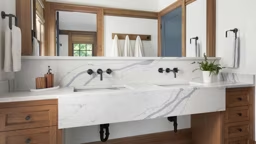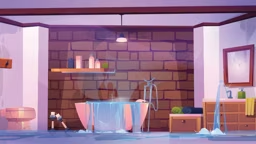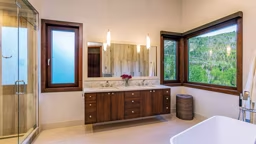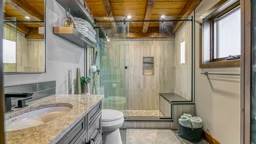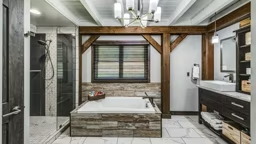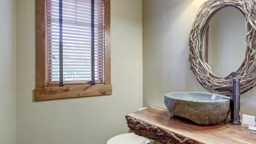
If the kitchen is the heart of the home, the bath is the private getaway. Making your bath a dream destination requires thoughtful planning. During the design phase, you need to consider factors such as location, space constraints, types of fixtures and finishes, and any special needs your family might have. Learn how to design a bathroom for your new home with the following tips. A variety of lighting styles can ensure safety in the bathroom, as well as create a relaxing ambience. Consider installing dimmers to control the mood.
Location
- For powder rooms, balance the need for privacy with the need for easy access to the half bath from any public space in the home (e.g., down a short hall instead of adjacent to a dining room or living room). If you enjoy outdoor activities like gardening or have children at home, consider placing the powder room close to an outdoor entrance to limit the amount of mud and dirt tracked indoors.
- For full bathrooms, consider where the bath will be in relation to the beds. (You may not want to hear water whooshing through the pipes in the wall directly behind your headboard.) Place large clothing closets away from the steamy atmosphere of the bath, advises Mary Fisher Knott, author of Kitchen and Bath Design: A Guide to Planning Basics. The moist air can be damaging to clothes.
- In a two-story home, stacking bathrooms above each other will help reduce the cost of plumbing installation.
Space
- According to Knott, a powder room requires about 30 square feet. A space that measures 5 by 9 feet is sufficient for a full bath.
- Your local building code will dictate certain minimum clearances. For instance, it may call for 21 inches of clear space in front of the toilet or 4 inches between a sink basin and the wall. Local codes may differ from national codes, so be sure you or your designer is aware of your municipality’s requirements at the start of the design process.
- To select fixtures and amenities for your baths, think about how you use your current bath. Knott suggests asking yourself a host of questions and sharing the answers with your bathroom designer: Are you right- or left-handed? Do you like to have toiletries and grooming appliances out in the open or tucked away? Would you like a seat in your shower?
Lighting and Electrical
- Lighting fixtures can be as ornate or streamlined as you like, as long as they provide adequate illumination and, if they are installed near the tub or shower, follow code for wet conditions.
- Multiple electrical outlets make a bath efficient and functional. Any located near water must be grounded. Your local codes may put additional restrictions on placement of outlets in terms of distance off the floor and proximity to the tub or shower.
- Special appliances, such as heated towel racks or bidet toilets, may require electrical wiring, so be sure to tell your designer or architect if you’d like to include these in your dream bathroom.
Finishes
- If a low-maintenance bath is high on your list of priorities, choose easy-to-clean finishes and fixtures, such as undermounted sinks, flat-front cabinet doors that won’t collect dust and vanities that mount to the wall, leaving the floor accessible underneath for easy sweeping and mopping.
- Choosing traditional colors for your fixtures will keep your bathroom from looking dated too quickly. If you want to add some pop, Cheryl Kees Clendenon of Indetail Interiors in Pensacola, Florida, suggests focusing color on the walls and in other decorative accessories.
Storage
- To be livable, your new bathroom must accommodate a host of items you use every day. Take a look at what you store in your bath now to make an honest assessment of the types of storage you’ll need.
- Knott suggests placing shallow cabinets between the studs or your bathroom walls. “That 8 inches of storage can be used for toilet paper rolls, or washcloths or toiletries,” she says.




